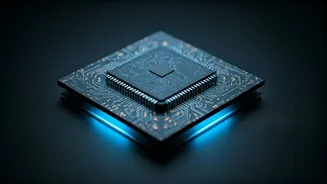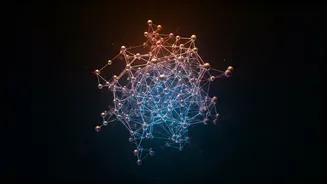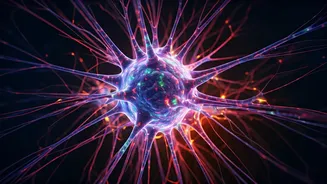Unveiling the Nanoscale
Nanoparticles are, fundamentally, incredibly small. To put it in perspective, they're thousands of times smaller than the width of a human hair. This tiny
size, however, is precisely what gives them their incredible potential. Due to their unique dimensions, nanoparticles exhibit properties that are drastically different from their larger counterparts. This is because at the nanoscale, the ratio of surface area to volume becomes exceptionally high, influencing how the particles interact with other materials and with light. These differences open up an entire universe of possibilities. They can be engineered to interact with biological systems, conduct electricity, or capture energy in unique ways. Scientists and engineers are harnessing these unique properties to design novel solutions across several fields, pushing the boundaries of what is possible. This means nanoparticles are no longer just a scientific curiosity, they're the building blocks for the future.
Applications in Medicine
The field of medicine is experiencing a significant transformation due to the advent of nanotechnology. Nanoparticles offer promising opportunities for targeted drug delivery. This means drugs can be specifically targeted to affected areas within the body, minimizing the side effects commonly associated with conventional treatments. Imaging techniques are also being enhanced by nanoparticles. They can be used to improve the visibility of diseased tissues and cells, aiding in early diagnosis. Nanoparticles are being tested for cancer treatment. Specifically, they have the capability to target cancer cells and release anti-cancer drugs directly at the site of the tumor. Research is also underway to use nanoparticles in diagnostics. They are being developed to detect diseases at the molecular level. These tiny machines are designed to interact with and react to biomolecules associated with different diseases, providing highly sensitive and early-stage diagnoses, opening up avenues for more effective treatment strategies.
Electronics Revolutionized
Nanoparticles play a crucial role in shaping the future of electronics. They offer the potential to create devices that are smaller, faster, and more efficient. The use of nanoparticles can increase the performance of semiconductors, allowing for the manufacture of more powerful and compact processors. They can be used to develop displays that are more vibrant and energy-efficient. Nanomaterials are being researched for use in solar cells, as they can capture sunlight more effectively than conventional materials. Also, in the world of data storage, nanoparticles are creating advancements. They are being used to manufacture memory devices that can store significantly more data than traditional storage solutions. These advancements are vital for the continued progress of electronics, as they provide for the needs of growing populations of electronics users, from smartphones to electric vehicles, and beyond.
Energy Innovations Emerge
Nanotechnology is making a significant impact on the energy sector. It presents new approaches to energy production, storage, and conservation. Nanomaterials are being utilized to increase the efficiency of solar panels. By enhancing the ability to capture sunlight, they make renewable energy more practical and cost-effective. Nanoparticles are critical in designing more effective batteries that can hold more energy and recharge more quickly. These developments are especially important as the world shifts toward electric vehicles and renewable energy sources. Furthermore, nanoparticles play a crucial part in the creation of fuel cells, which convert chemical energy into electrical energy efficiently. Fuel cells promise a cleaner and more sustainable energy solution. All these innovations driven by nanotechnology are essential for securing a sustainable energy future, reducing our reliance on fossil fuels, and mitigating climate change.
Atomic Stencils Explained
One of the innovative techniques used to create these tiny structures is the application of atomic stencils. Scientists use these stencils to precisely control the placement of atoms, enabling the design of nanoparticles with desired shapes and characteristics. These atomic stencils are highly specialized tools, allowing scientists to create nanoparticles with exceptional precision. The process involves creating patterns, usually on a surface, that act as a template. Scientists then deposit atoms or molecules onto these templates. The stencil ensures the atoms are arranged in a specific way, leading to the creation of the desired nanoparticle. This process is similar to using a stencil to spray-paint a design. The atomic stencils allow for an unprecedented level of control over the structure of nanoparticles. Therefore, they are vital to the creation of advanced materials with tailored properties and specific applications in various fields.
Challenges and Future
The path to harnessing the full potential of nanoparticles isn't without its challenges. One of the main hurdles is scalability: making these nanoparticles in large quantities without compromising their unique properties can be difficult. Ensuring the safety of nanoparticles is another key concern, especially concerning potential environmental and health implications. Further research is necessary to fully understand the effects of nanoparticles on living organisms and ecosystems. However, the future of nanoparticles is incredibly bright. Ongoing research will continue to fine-tune existing applications and unveil new ones. The development of advanced manufacturing techniques and a deeper understanding of the properties of nanoparticles will open new opportunities. Collaboration between scientists, engineers, and policymakers is vital to ensure that nanoparticles are safely and sustainably integrated into our world. This will result in groundbreaking advances in medicine, electronics, energy, and beyond.










